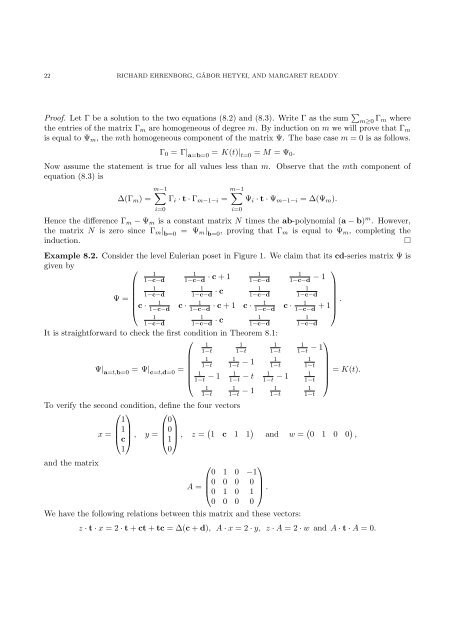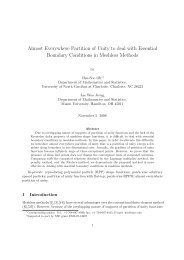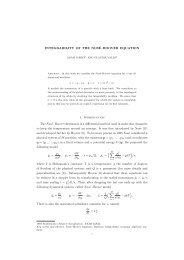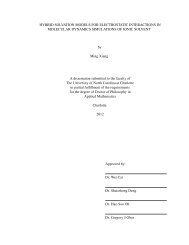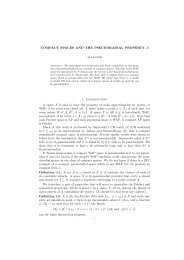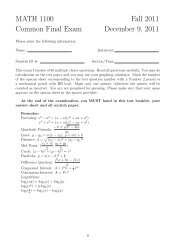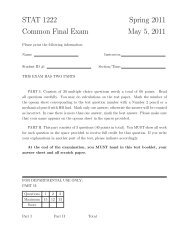LEVEL EULERIAN POSETS 1. Introduction It is the instinct of every ...
LEVEL EULERIAN POSETS 1. Introduction It is the instinct of every ...
LEVEL EULERIAN POSETS 1. Introduction It is the instinct of every ...
Create successful ePaper yourself
Turn your PDF publications into a flip-book with our unique Google optimized e-Paper software.
22 RICHARD EHRENBORG, GÁBOR HETYEI, AND MARGARET READDY<br />
Pro<strong>of</strong>. Let Γ be a solution to <strong>the</strong> two equations (8.2) and (8.3). Write Γ as <strong>the</strong> sum <br />
m≥0 Γm where<br />
<strong>the</strong> entries <strong>of</strong> <strong>the</strong> matrix Γm are homogeneous <strong>of</strong> degree m. By induction on m we will prove that Γm<br />
<strong>is</strong> equal to Ψm, <strong>the</strong> mth homogeneous component <strong>of</strong> <strong>the</strong> matrix Ψ. The base case m = 0 <strong>is</strong> as follows.<br />
Γ0 = Γ| a=b=0 = K(t)| t=0 = M = Ψ0.<br />
Now assume <strong>the</strong> statement <strong>is</strong> true for all values less than m. Observe that <strong>the</strong> mth component <strong>of</strong><br />
equation (8.3) <strong>is</strong><br />
∆(Γm) =<br />
m−1 <br />
i=0<br />
Γi · t · Γm−1−i =<br />
m−1 <br />
i=0<br />
Ψi · t · Ψm−1−i = ∆(Ψm).<br />
Hence <strong>the</strong> difference Γm − Ψm <strong>is</strong> a constant matrix N times <strong>the</strong> ab-polynomial (a − b) m . However,<br />
<strong>the</strong> matrix N <strong>is</strong> zero since Γm| b=0 = Ψm| b=0 , proving that Γm <strong>is</strong> equal to Ψm, completing <strong>the</strong><br />
induction. <br />
Example 8.2. Consider <strong>the</strong> level Eulerian poset in Figure <strong>1.</strong> We claim that its cd-series matrix Ψ <strong>is</strong><br />
given by<br />
⎛<br />
1<br />
1−c−d<br />
⎜ 1<br />
⎜ 1−c−d<br />
Ψ = ⎜ 1<br />
⎝<br />
c · 1−c−d<br />
1<br />
1−c−d · c + 1<br />
1<br />
1−c−d · c<br />
1 c · 1−c−d<br />
1<br />
1−c−d<br />
1<br />
1−c−d<br />
1<br />
1−c−d − 1<br />
1<br />
1−c−d<br />
· c + 1 c · 1<br />
1−c−d<br />
⎞<br />
⎟ .<br />
1 c · 1−c−d + 1⎟<br />
⎠<br />
1<br />
1−c−d<br />
1<br />
1−c−d · c<br />
1<br />
1−c−d<br />
1<br />
1−c−d<br />
<strong>It</strong> <strong>is</strong> straightforward to check <strong>the</strong> first condition in Theorem 8.1:<br />
⎛<br />
1<br />
1<br />
1<br />
1−t 1−t 1−t<br />
⎜ 1 1<br />
1<br />
⎜ 1−t 1−t − 1 1−t<br />
Ψ| a=t,b=0 = Ψ| c=t,d=0 = ⎜ 1<br />
1<br />
1<br />
⎝ 1−t − 1 1−t − t 1−t − 1<br />
⎞<br />
1<br />
1−t − 1<br />
⎟<br />
1 ⎟<br />
1−t ⎟ = K(t).<br />
1 ⎟<br />
1−t ⎠<br />
1<br />
1−t<br />
1<br />
1−t − 1 1<br />
1−t<br />
1<br />
1−t<br />
To verify <strong>the</strong> second condition, define <strong>the</strong> four vectors<br />
⎛ ⎞ ⎛ ⎞<br />
1<br />
0<br />
⎜<br />
x = ⎜1⎟<br />
⎜<br />
⎟<br />
⎝c⎠<br />
, y = ⎜0<br />
⎟<br />
⎝1⎠<br />
1<br />
0<br />
, z = 1 c 1 1 <br />
and <strong>the</strong> matrix<br />
⎛<br />
0<br />
⎜<br />
A = ⎜0<br />
⎝0<br />
1<br />
0<br />
1<br />
0<br />
0<br />
0<br />
⎞<br />
−1<br />
0 ⎟<br />
1 ⎠<br />
0 0 0 0<br />
.<br />
We have <strong>the</strong> following relations between th<strong>is</strong> matrix and <strong>the</strong>se vectors:<br />
and w = 0 1 0 0 ,<br />
z · t · x = 2 · t + ct + tc = ∆(c + d), A · x = 2 · y, z · A = 2 · w and A · t · A = 0.


